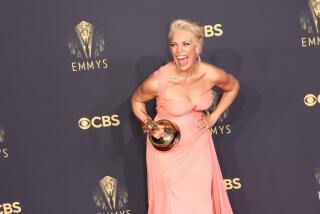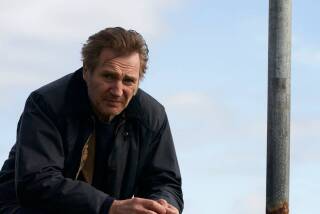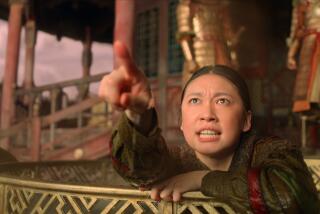‘Game of Thrones’ season 4: Fighting for honor on Belfast set
It’s a winding two-lane road in the Northern Irish countryside that leads past grazing cattle to the open fields of Clandeboye Estate, a placid locale famed for its dairy products and its wedding receptions. But as sunset arrived on a mild September evening, the property hosted a ceremony of another kind.
HBO’s lavish fantasy “Game of Thrones” had come to shoot a tricky fight scene for an episode of its fourth season, which begins its highly anticipated 10-show run Sunday. Inside the cramped confines of a rustic wooden structure, actor Kit Harington, clad in the Night’s Watch black of his noble character Jon Snow, was on the receiving end of troubling blows.
Candles cast a warm, golden glow and magnificent shadows over the action inside the set, as Harington, blood painted onto his cheeks, and his sparring partner rehearsed the choreography of the fight scene. At one point, the actor playing his adversary (to reveal the performer’s identity would spoil a key surprise) was wondering aloud whether to kick Harington more enthusiastically to sweep his leg out from beneath him.
“No more energy in the kick. That’s my bad ankle,” said Harington, 27, referring to a 2012 injury he sustained after attempting to crawl through the window of his London home to retrieve his keys and landing badly in a fall.
The actor wasn’t worried about being able to telegraph the right motion for the screen: “I’ll sell it,” he said.
“Game of Thrones” fans hardly need reminding that death and destiny are often inseparable in the brutal realm of Westeros. The HBO series seems to relish dispatching characters with a mischievous glee, and the ominous tag line teasing the fourth season, “All men must die,” suggests that more bloodshed is on the way.
“It’s been expanding for so long. [Now] we’re starting to get to the place where it will contract,” said David Benioff, who along with D.B. Weiss created “Game of Thrones” and serves as an executive producer. “Characters will get killed off, characters who have never met before start to come together, and this massive world that George Martin created in his books is now going to start to become slightly less massive.”
Adapted from the bestselling “A Song of Ice and Fire” novels by author George R.R. Martin, “Game of Thrones” arrived in 2011 as an expensive gamble: Would viewers respond to a densely plotted political fantasy involving betrayal, incest and fire-breathing dragons?
Turns out the answer was a resounding yes. Over the course of three seasons, the series evolved from a well-pedigreed curiosity to one of television’s most discussed (and most expensive) marquee programs.
In its third season, about 5 million people tuned in for “Game of Thrones” each Sunday, though when adding DVR playbacks, video on demand and other platforms, the audience more than doubled. It’s won eight Emmys, including one for supporting actor Peter Dinklage’s performance as the cunning Tyrion Lannister.
As a cultural touch point, the series’ zenith might have arrived last June with the episode titled “The Rains of Castamere,” an installment that saw three characters meet especially gruesome ends at the so-called Red Wedding. Moments after the episode concluded, the Internet exploded with outrage — a Twitter account called @RedWeddingTears amassed more than 9,000 followers in less than 24 hours, and fans posted reaction videos on YouTube to chronicle their shock and despair over such a cruel twist in the narrative.
“I think people have kind of moved on to acceptance by now. Isn’t that the last stage of grief?” joked Benioff by telephone late last month.
“I hope it doesn’t go back around to anger again,” Weiss said.
As Season 4 gets underway, the impact of the Red Wedding is being felt across Westeros and by “Game of Thrones’” key players. Surviving Stark sisters Sansa (Sophie Turner) and Arya (Maisie Williams) are hungry for revenge; the conniving Lannister clan, including the sadistic King Joffrey (Jack Gleeson), believes the rebellion fomented by the late Robb Stark is largely drawing to an end, even though plenty of others have designs on the Iron Throne, including the gruff Stannis Baratheon (Stephen Dillane), who is advised by the Red Priestess Melisandre (Carice van Houten).
Also seeking to rule is Daenerys Targaryen (Emilia Clarke), who continues her campaign in across-the-sea Essos, freeing the citizens of various slave states as she conquers distant kingdoms with her army of warriors known as the Unsullied. Meanwhile, Snow prepares for a Wildling invasion at the Wall, the northernmost point of the Seven Kingdoms where the Night’s Watch order lives a monastic existence. “It’s the biggest season we’ve done in terms of more action scenes than we’ve ever had before, more visual effects components,” Benioff said.
In terms of sheer scale, “Game of Thrones” is largely unmatched on television. The production is based in Belfast in a converted ship painting facility where the finishing touches were once placed on the Titanic. After the series outgrew the original 64,000 square feet at the converted soundstages, an additional 44,000 square feet were constructed. The show also films around Northern Ireland and travels to exotic locales including Iceland and Croatia.
Even if the focus of the narrative begins to narrow with Season 4, there are new characters who enter the story, including Oberyn Martell (Pedro Pascal), a prince from the land of Dorne known as the Red Viper, who makes a memorable debut in the season premiere.
Secrets have always been among the most prized currency in Westeros, and the details of any of “Game of Thrones’” story lines are guarded with the ferocity of an army of White Walkers. Which can make the prospect of ferreting out what lies ahead a difficult proposition.
“I think the dark places that we go to in Season 4 are unlike any other season so far,” Clarke said in a phone interview. “It’s on so many levels. It’s not just blood, it’s bigger than that. Both the characters and hopefully the audience are so invested in the plots and the characters at this stage that the revelations you’ll see really just take it up a notch and somewhere even darker.”
Martin’s novels offer clues about the future, of course — Season 4 is based largely on the second half of the third book in the series, “A Storm of Swords,” though it weaves in events and characters from other installments — but only Benioff and Weiss know precisely what’s in store. The show runners finished outlining the series’ fifth season in February and are writing scripts now.
The rapid clip at which they’re moving through the books’ plot has generated deep concern and much speculation — Martin has yet to publish either the sixth or the final installment in what has long been planned as a seven-novel series, making for the very real possibility that the show could end before the author completes his manuscripts (each of the existing novels in paperback runs roughly between 800 and 1,000 pages).
The “Game of Thrones” creators, however, are not taking steps to slow the series’ pace or invent more original scenes to delay the point at which they arrive at the end of the narrative Martin has penned.
“I think that would be what kills the show, if we succumbed to that kind of pressure and tried to stretch it out to make it last for longer than it should last,” Benioff said.
They have met with the author to discuss his intended resolution for each of the characters’ arcs. They dismissed rumors that the show could make the jump to the big screen and end with one or more films.
“We’re so in the television show of it all at this point,” Weiss said. “Obviously, there’s something fabulous about epic events on the big screen, but right now we’re thinking about the TV show as a TV show. That’s something that a lot of people would have to agree to before that could become a reality.”
“Season 4 is about to air, and Season 5 and 6 we know will be on television, and beyond that is too far out to speculate,” Benioff added.
Back on set under a Belfast moon, Harington seemed like a man who’d be game to put a cinematic spin on Snow’s adventures. The young Brit honed his leading man action skills in the period volcano adventure “Pompeii,” but it’s as the striving underdog that he’s most strongly connected with audiences. His dedication to the role, the first he ever landed in a television series, is considerable.
Looking to perfect that fight scene, Harington threw himself to the ground with a painful-sounding thud, replaying the move over and over as the scene was shot first from the villain’s perspective, then his. Each time through, Harington wore a mask of determination, yet the wild gleam in his eyes conveyed Snow’s awareness that the encounter could end in his demise.
“Everybody always talks, talks, talks in lovely comfortable rooms or on the beach in Croatia,” Harington said of his cast mates. “Sometimes you’re like, ‘Oh, wouldn’t mind doing some of that,’ but actually doing this kind of stuff, the real action, sometimes I think they’re envious of us, those people doing the talking in warm rooms. You get to throw a sword around and look like a hero, and it’s fun and gritty and real.”
More to Read
The biggest entertainment stories
Get our big stories about Hollywood, film, television, music, arts, culture and more right in your inbox as soon as they publish.
You may occasionally receive promotional content from the Los Angeles Times.







